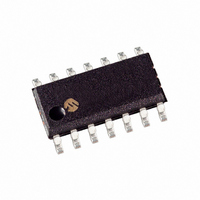PIC16F630-I/SL Microchip Technology, PIC16F630-I/SL Datasheet - Page 37

PIC16F630-I/SL
Manufacturer Part Number
PIC16F630-I/SL
Description
IC MCU FLASH 1KX14 EEPROM 14SOIC
Manufacturer
Microchip Technology
Series
PIC® 16Fr
Datasheets
1.PIC16F616T-ISL.pdf
(8 pages)
2.PIC12F629T-ISN.pdf
(24 pages)
3.PIC16F630-ISL.pdf
(132 pages)
4.PIC16F630-ISL.pdf
(2 pages)
5.PIC16F630-ISL.pdf
(10 pages)
6.PIC16F676-EP.pdf
(132 pages)
7.PIC16F676-ISL.pdf
(130 pages)
Specifications of PIC16F630-I/SL
Program Memory Type
FLASH
Program Memory Size
1.75KB (1K x 14)
Package / Case
14-SOIC (3.9mm Width), 14-SOL
Core Processor
PIC
Core Size
8-Bit
Speed
20MHz
Peripherals
Brown-out Detect/Reset, POR, WDT
Number Of I /o
12
Eeprom Size
128 x 8
Ram Size
64 x 8
Voltage - Supply (vcc/vdd)
2 V ~ 5.5 V
Oscillator Type
Internal
Operating Temperature
-40°C ~ 85°C
Processor Series
PIC16F
Core
PIC
Data Bus Width
8 bit
Data Ram Size
64 B
Interface Type
RS- 232/USB
Maximum Clock Frequency
20 MHz
Number Of Programmable I/os
12
Number Of Timers
2
Operating Supply Voltage
2 V to 5.5 V
Maximum Operating Temperature
+ 85 C
Mounting Style
SMD/SMT
3rd Party Development Tools
52715-96, 52716-328, 52717-734
Development Tools By Supplier
PG164130, DV164035, DV244005, DV164005, PG164120, ICE2000, DM163014, DM164120-4
Minimum Operating Temperature
- 40 C
Package
14SOIC N
Device Core
PIC
Family Name
PIC16
Maximum Speed
20 MHz
Lead Free Status / RoHS Status
Lead free / RoHS Compliant
Data Converters
-
Connectivity
-
Lead Free Status / Rohs Status
Lead free / RoHS Compliant
Available stocks
Company
Part Number
Manufacturer
Quantity
Price
Company:
Part Number:
PIC16F630-I/SL
Manufacturer:
TriQuint
Quantity:
1 200
Company:
Part Number:
PIC16F630-I/SL
Manufacturer:
MICROCHI
Quantity:
1 743
Part Number:
PIC16F630-I/SL
Manufacturer:
MICROCHIP/微芯
Quantity:
20 000
5.4
If control bit T1SYNC (T1CON<2>) is set, the external
clock input is not synchronized. The timer continues to
increment asynchronous to the internal phase clocks.
The timer will continue to run during Sleep and can
generate an interrupt on overflow, which will wake-up
the processor. However, special precautions in
software
(Section 5.4.1).
5.4.1
Reading TMR1H or TMR1L, while the timer is running
from an external asynchronous clock, will ensure a
valid read (taken care of in hardware). However, the
user should keep in mind that reading the 16-bit timer
in two 8-bit values itself, poses certain problems, since
the timer may overflow between the reads.
For writes, it is recommended that the user simply stop
the timer and write the desired values. A write conten-
tion may occur by writing to the timer registers, while
the register is incrementing. This may produce an
unpredictable value in the timer register.
Reading the 16-bit value requires some care.
Examples 12-2 and 12-3 in the PIC
Family Reference Manual (DS33023) show how to
read and write Timer1 when it is running in
Asynchronous mode.
TABLE 5-1:
2010 Microchip Technology Inc.
0Bh/8Bh INTCON
0Ch
0Eh
0Fh
10h
8Ch
Legend: x = unknown, u = unchanged, - = unimplemented, read as ‘0’. Shaded cells are not used by the Timer1 module.
Address
Note:
Timer1 Operation in
Asynchronous Counter Mode
READING AND WRITING TIMER1 IN
ASYNCHRONOUS COUNTER MODE
PIR1
TMR1L
TMR1H
T1CON
PIE1
are
The ANSEL (91h) and CMCON (19h)
registers must be initialized to configure an
analog channel as a digital input. Pins
configured as analog inputs will read ‘0’.
The ANSEL register is defined for the
PIC16F676.
Name
needed
REGISTERS ASSOCIATED WITH TIMER1 AS A TIMER/COUNTER
Holding Register for the Least Significant Byte of the 16-bit TMR1 Register
Holding Register for the Most Significant Byte of the 16-bit TMR1 Register
Bit 7
EEIF
EEIE
GIE
—
TMR1GE T1CKPS1 T1CKPS0 T1OSCEN T1SYNC TMR1CS TMR1ON -000 0000 -uuu uuuu
to
PEIE
ADIF
ADIE
Bit 6
read/write
®
Mid-Range MCU
Bit 5
T0IE
—
—
the
INTE
Bit 4
timer
—
—
CMIE
RAIE
CMIF
Bit 3
5.5
A crystal oscillator circuit is built-in between pins OSC1
(input) and OSC2 (amplifier output). It is enabled by
setting control bit T1OSCEN (T1CON<3>). The oscilla-
tor is a low power oscillator rated up to 32 kHz. It will
continue to run during Sleep. It is primarily intended for
a 32 kHz crystal. Table 9-2 shows the capacitor
selection for the Timer1 oscillator.
The Timer1 oscillator is shared with the system LP
oscillator. Thus, Timer1 can use this mode only when
the system clock is derived from the internal oscillator.
As with the system LP oscillator, the user must provide
a software time delay to ensure proper oscillator
start-up.
TRISA5 and TRISA4 bits are set when the Timer1
oscillator is enabled. RA5 and RA4 read as ‘0’ and
TRISA5 and TRISA4 bits read as ‘1’.
5.6
Timer1 can only operate during Sleep when setup in
Asynchronous Counter mode. In this mode, an external
crystal or clock source can be used to increment the
counter. To setup the timer to wake the device:
• Timer1 must be on (T1CON<0>)
• TMR1IE bit (PIE1<0>) must be set
• PEIE bit (INTCON<6>) must be set
The device will wake-up on an overflow. If the GIE bit
(INTCON<7>) is set, the device will wake-up and jump
to the Interrupt Service Routine on an overflow.
Note:
Bit 2
T0IF
—
—
Timer1 Oscillator
Timer1 Operation During Sleep
The oscillator requires a start-up and
stabilization
T1OSCEN should be set and a suitable
delay observed prior to enabling Timer1.
Bit 1
INTF
PIC16F630/676
—
—
TMR1IF 00-- 0--0 00-- 0--0
TMR1IE 00-- 0--0 00-- 0--0
RAIF
Bit 0
time
0000 0000 0000 000u
xxxx xxxx uuuu uuuu
xxxx xxxx uuuu uuuu
before
POR, BOD
Value on
DS40039F-page 37
use.
Value on
all other
Resets
Thus,


















